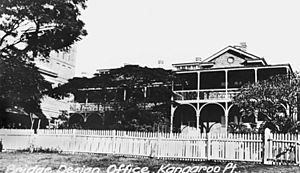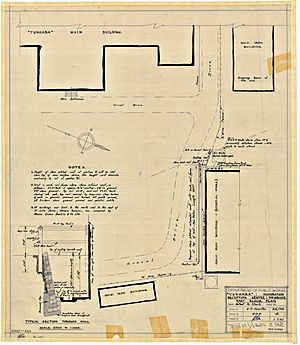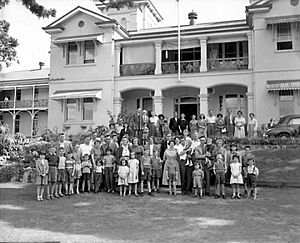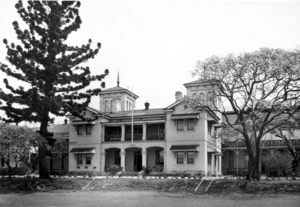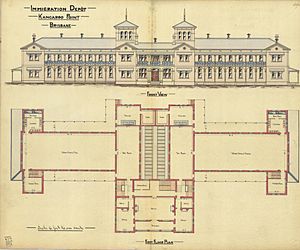Yungaba Immigration Centre facts for kids
Quick facts for kids Yungaba Immigration Centre |
|
|---|---|
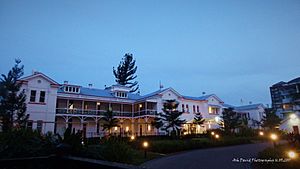
Yungaba Immigration Centre, September 2017
|
|
| Location | Yungaba, 102 Main Street, Kangaroo Point, City of Brisbane, Queensland, Australia |
| Design period | 1870s - 1890s (late 19th century) |
| Built | c. 1885 - 1899 |
| Architect | John James Clark |
| Architectural style(s) | Italianate |
| Official name: Yungaba Immigration Depot, Immigration Barracks, No.6 Australian General Hospital | |
| Type | state heritage (built) |
| Designated | 21 October 1992 |
| Reference no. | 600245 |
| Significant period | 1880s (fabric) 1880s-1980s (historical) |
| Significant components | trees/plantings, out building/s |
| Builders | William Peter Clark |
| Lua error in Module:Location_map at line 420: attempt to index field 'wikibase' (a nil value). | |
Yungaba Immigration Centre is a special old building in Kangaroo Point, Brisbane, Australia. It sits right next to the Brisbane River. This building was once a place where people arriving in Queensland from other countries could stay.
It was designed by an architect named John James Clark and built around 1885. Over the years, it has been known by different names, like Yungaba Immigration Depot and even No.6 Australian General Hospital. In 2009, Yungaba was named one of the "Q150 Icons" of Queensland. This was because it played a big part in shaping the state's history.
A Look Back: Yungaba's Story
Yungaba is a two-storey brick building. It was planned in 1885 by John James Clark, who was the main architect for the Queensland Government. After he left his job, other architects helped finish the plans. William Peter Clark built the centre. It has a style that mixes Italian and Queensland building ideas.
Early Land Use
The land where Yungaba stands was first divided into smaller blocks in 1843-44. Later, a man named John "Tinker" Campbell bought some of this land. He moved his animal processing business there to use a small stream.
In 1853, Robert Douglas bought the land for £400. He built a house called "The Willows" on one of the blocks. Douglas was a well-known person in Brisbane. In 1884, he sold his property to the government for a much higher price, £14,000.
Why Yungaba Was Built
The government knew that the old immigration buildings in William Street were not good enough. They decided to buy the land at Kangaroo Point. They wanted to give new arrivals a "pleasant place" to stay.
Many people were coming to Queensland around this time. William Peter Clark won the job to build the new centre. But he faced many problems, which made the building take almost a year longer to finish.
The inside of the building was designed by William Hodgen. It was set up like other large buildings of that time. Married people had their own small rooms on the ground floor. Single people stayed in large shared rooms (dormitories) upstairs. Men and women had separate dormitories. Toilets and laundry areas were built behind the main building.
The first people to stay at Yungaba arrived on a ship called Duke of Buccleuch on 6 December 1887.
Early Challenges and Changes
The first manager of Yungaba was William Edward Parry-Okeden. He was a very capable and fair person. He and his family moved to Brisbane to work at the centre. He later became an important government official.
Parry-Okeden quickly saw problems at Yungaba. There were issues with drainage, which made the building damp. The bricks used were not very good, making the dampness worse. Gas and water connections were poor or missing.
There was also no proper wharf for ships to drop off immigrants. At high tide, the wharf was cut off by water. At low tide, the water was too shallow for ships to get close. It took many requests to fix these problems.
In 1889, there was an outbreak of scarlet fever. This showed the urgent need for special rooms to treat sick immigrants. A facility was built, but it had no gas, water, or proper drainage. A "disinfecting plant" also had problems, being vandalized and flooded.
Changing Uses Over Time
When fewer immigrants arrived, Yungaba was used for other purposes.
- In 1900, it temporarily housed people from the Dunwich Asylum. This was because their usual home was used for people with the plague.
- From 1904 to 1906, it housed South Sea Islanders who were being sent back to their home countries. When an immigrant ship arrived, the Islanders had to move to rented homes nearby. This was because it was thought "inappropriate" for the two groups to live together.
During World War I, Yungaba became a military hospital. Not many changes were made to the building itself. After the war, it was used to welcome returning soldiers and their families.
In the 1930s, during the Great Depression, fewer people came to Australia. Yungaba was then used by the team building the Story Bridge. The main engineer, John Bradfield, had an office there. The upper floor was used for offices and drawing rooms. Extra windows were added to let in more light for the draftsmen.
The company building the bridge, Evans Deakin, turned the grounds into a work site. They built workshops and storage sheds. These sheds blocked the view between Yungaba and the river for a while.
When World War II started, Yungaba housed women and children evacuated from Hong Kong in 1940. In 1941, it became a general hospital again. Most of the buildings used for patients at that time are now gone.
Post-War and Modern Era
After World War II, many more immigrants came to Australia. The building was renamed Yungaba State Immigration Office and Reception Centre. "Yungaba" comes from an Aboriginal language and means "place of sunshine."
Yungaba could only hold a small number of new arrivals. Most were sent to empty military camps, like Camp Columbia at Wacol.
During this time, Yungaba had its biggest changes. Small rooms were added downstairs. Toilets were updated, and the kitchen was made bigger. The outside bricks were painted white.
Over the years, there have been other small changes. In 1990, the verandahs were rebuilt. In 1993, the building was changed to offices for the Department of Family Services. The sheds that blocked the river view were removed, and new buildings were put up in the 1970s that kept the view open.
In 1988, Yungaba was the first building added to the Queensland Estate Register. This showed how important it was to the community. Yungaba stopped being used for immigration between 1993 and 1995.
In 2008, the Queensland Government sold Yungaba to developers. They have restored the old building and turned it into ten apartments. They also built more apartments and a multicultural centre nearby. The new buildings do not block the river views from Yungaba.
What Yungaba Looks Like
Yungaba is on Main Street in Kangaroo Point, Brisbane. It has a great spot on the banks of the Brisbane River, right next to the Story Bridge. The main way to see the building is from the river. However, most people enter from Main Street, which takes you to the back of the building. Here, you can see other smaller buildings that were used for different things over time.
Yungaba has a balanced, cross-shaped design. It has a large entrance area in the middle with two three-storey towers on either side. These towers mark the main entrance and where the two wings of the building begin. The building is made of brick with timber floors and roof. The roof has intersecting gables and pointed roofs on the towers. It is covered with corrugated metal.
Verandahs run along the sides of the building's wings. They have timber posts and railings with decorative cast iron panels. Some parts of the verandahs are enclosed with lattice screens. Windows not covered by verandahs have sunhoods made of cast iron and timber.
Inside, the central part of the building still looks much like it did originally. The north and south wings, which were once open spaces, have been changed into offices and function areas. On the ground floor, these areas are now smaller rooms with a central hallway. The upper floor is mostly open, with offices near the centre. These changes can usually be reversed, and much of the original building is still there.
The gardens around the building were mostly created after World War II. On the river side, a road loops past the entrance. There are many old and new plants along this road. The central area is mostly grass. A newer function room, made of brick, is in the southeast corner, facing the river.
Behind the building, there is a car park and several smaller buildings. These are single-storey and made of brick or timber. They have simple gable or hip roofs covered with corrugated metal.
Another newer building is located across the access road to the north of Yungaba. This two-storey brick building is visually separate from Yungaba. This is because it is on lower ground and there are many mature trees between the two buildings.
Why Yungaba is a Heritage Site
Yungaba Immigration Depot was added to the Queensland Heritage Register on 21 October 1992. This means it is a very important historical place.
Showing Queensland's History
Yungaba shows how important immigration was in the late 1800s. It also shows how the government helped new arrivals. Queensland had very large immigration programs, bringing in more people than any other Australian colony or state at the time.
A Special Type of Building
Yungaba is a great example of a large public building from the late 1800s. Its balanced design and the way it was decorated show its different uses. The fact that much of the original building is still there tells us how important immigration was when it was built.
It also shows what kind of accommodation new immigrants received. The original layout, with separate dormitories for single men and women, and private rooms for families, tells us about ideas of privacy and behaviour at that time.
Beautiful Design
Yungaba is considered beautiful by many people. It stands elegantly on the banks of the Brisbane River, with clear views to the water. Its simple but graceful design makes it look less strict, even though it was a large, official building.
Important to the Community
Yungaba has a special connection with many different groups of people. It has housed generations of immigrants. It welcomed soldiers and their families returning from three major wars. It also housed South Sea Islanders before they were sent home. It is closely linked to the building of the Story Bridge, a famous Brisbane landmark. Its listing as the first building protected under a special law shows how much the community values it.
Connected to Important People
Yungaba is linked to the work of J. J. Clark, the Colonial Architect. It is also connected to William Parry-Okeden, who was later a very important government official. Parry-Okeden helped solve major conflicts like the shearers' strikes and issues with the Native Police. He also played a big role in the government's relationship with Aboriginal people because he knew many Aboriginal languages.


